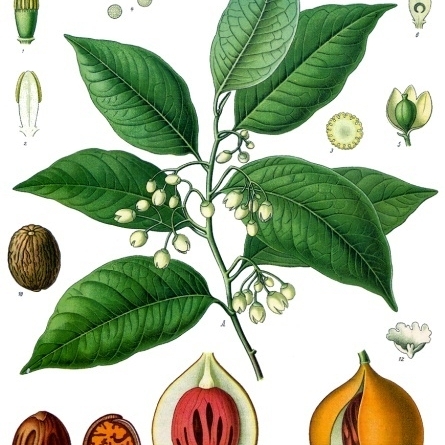Trees or very occasionally lianes, dioecious or rarely monoecious, frequently aromatic, evergreen or rarely deciduous (some Virola species). Leaves alternate, entire, pinnately nerved, sometimes with gland dots; stipules absent. Inflorescences axillary or extra-axillary, rarely terminal, capitate, umbellate, fascicled or racemose, the partial inflorescences in fairly lax to dense panicles or compound heads; bracts often present, usually deciduous; bracteoles mostly absent. Flowers with perianth infundibuliform, campanulate, urceolate or patelliform with (2–)3–4(–5) valvate lobes. Male flowers: stamens 2–30(–40); filaments joined into a column; anthers adnate to the column, arranged in a ring, free, or fused into a globular mass, 2-thecous, muticous or slightly apiculate, dehiscing by longitudinal slits; rudimentary ovary absent. Female flowers: ovary 1-locular, superior, usually sessile; style very small or absent; stigmas 2, indistinct, ± joined; ovule 1, usually anatropous. Fruits with fleshy or leathery pericarp, mostly dehiscent into 2 valves. Seeds with a thin or fleshy often highly coloured entire, lobed or laciniate aril; testa usually in 3 layers, the outer membranous or fleshy, the middle one woody, the inner one membranous and usually intruding into the folds of the endosperm; endosperm abundant, entire or ruminate, very oily; embryo very small, with basal suberect, spreading or connate cotyledons
Trees or rarely shrubs, dioecious or rarely (not in Australia) monoecious. Indumentum of sympodially branched uniseriate trichomes. Leaves simple, alternate, exstipulate. Inflorescences mostly axillary. Bracts small, caducous. Flowers small, hypogynous, unisexual. Calyx gamophyllous, becoming 2–5-cleft. Petals absent. Male flowers: vestigial gynoecium absent; stamens 2–many; connectives and filaments united into a column or connate only at base; anthers partially or completely connate or (not in Australia) free, extrorse, dehiscing longitudinally. Female flowers: staminodes absent; ovary a single, conduplicate, unsealed carpel usually with a simple or bilobed, sessile or subsessile stigma, rarely (not in Australia) on a long style; ovule solitary, nearly basal, anatropous. Fruit with thick pericarp, usually dehiscent by longitudinal sutures into 2 valves. Seed with a well-developed aril; endosperm abundant, ruminate or not; cotyledons sometimes connate at base; embryo small.
Seeds partially or completely enveloped by an often brightly coloured laciniate or subentire fleshy aril; testa usually in 3 layers, the outer membranous or fleshy, the middle one woody and the inner one membranous, usually intruding into the folds of the endosperm; endosperm abundant, entire or ruminate, very oily; embryo very small with basal suberect, spreading or connate cotyledons
Seeds erect, with a thin or fleshy, sometimes laciniate, often coloured aril; endosperm copious, replete with fat and often starch, mostly ruminate; embryo small; cotyledons ascending or spreading, sometimes connate
Male flowers with 2–30(40) stamens; filaments partially or completely fused into a column; anthers laterally connate, rarely free, 2-thecous, dehiscing by longitudinal slits; rudimentary ovary absent
Inflorescences paniculate, fasciculate-racemose, or capitate, sometimes apparently cymose; bracts often present, usually deciduous, bracteoles mostly absent
Flowers unisexual, small, actinomorphic, whitish-yellow, pink or red; perianth saucer-or funnel-shaped, campanulate or urceolate, (2)3–4(5)-valvately lobed
Male flower: stamens 2–30; filaments united into a column; anthers 2-celled, free or united in a mass, dehiscing longitudinally; rudimentary ovary absent
Female flowers 1-carpellate; ovary superior, usually sessile; style small or absent; stigmas ± 2-lobed; ovule 1, usually anatropous
Trees or shrubs, rarely lianes, evergreen or rarely deciduous, often aromatic, dioecious or monoecious, sap coloured
Female flower: staminodes absent; ovary superior, sessile, 1-celled; stigma subsessile; ovule 1, almost basal
Calyx 3-(rarely 2–5–) lobed, funnel-shaped to globose or saucer-shaped, lobes valvate
Fruits a drupe with a fleshy or leathery pericarp, mostly dehiscing into 2 valves
Leaves alternate, entire, penninerved, often with pellucid dots; stipules absent
Flowers small, dioecious, apetalous, fascicled, racemose, umbellate or capitate
Indumentum of stellate-branching, shortly-stalked T-shaped or uniseriate hairs
Leaves alternate, simple, entire, often gland-dotted; exstipulate
Fruit fleshy, usually dehiscing by two valves
Trees, often large and frequently aromatic

